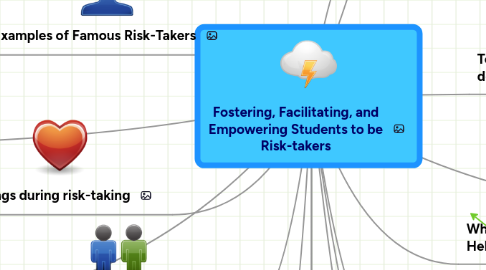
1. Providing opportunities for leadership in the class
1.1. Creating a class culture of being helpful and supportive
2. Placing a value on creativity and "out of the box" thinking
2.1. Modeling creative thinking
2.1.1. Teacher "Think-Alouds"
2.1.1.1. student think-alouds
3. Celebrating accomplishments and achievements with parties and special activities
3.1. End of the year party with small group
3.2. Award ideas: "Most Tries," "Biggest Stretch of the Imagination," "Stupid Idea Award" (the latter is to be the most coveted, because stupid ideas can turn out to be smart or lead to an idea for a smarter solution)
4. Examples of Famous Risk-Takers
4.1. past
4.1.1. present
4.1.1.1. war generals
4.1.1.2. politicians
4.1.1.3. musicians
4.1.2. people who make investments
4.1.3. Copernicus
4.1.4. Milton Hershey
4.1.5. Abraham Lincoln
5. Multicultural and Global Connections
5.1. Teaching students to be culturally competent and culturally sensitive
5.1.1. Identifying learning communities around the world
5.1.1.1. Identifying projects for the purpose of global collaboration
5.1.1.1.1. Seeking and selecting global learning partner, learning community, or classroom
6. Feelings during risk-taking
6.1. fear
6.2. exhiliration
6.3. confidence
7. Sharing our own personal risks - Class activity (K-2) - Have your students brainstorm a list of risks they may have taken. Make a graph representing the results.
7.1. Riding a bike
7.2. Learning to swim
7.3. Climbing a tree
7.4. Hiking up and down a mountain
7.5. Going in a canoe
7.6. Cooking (with parental supervision)
8. New node
9. Providing stimulating assignments where students create meaningful work
9.1. Contructing knowledge for themselves
9.1.1. Tackling a controversial issue in school
9.1.1.1. Racism
9.1.1.2. School uniforms
9.1.1.3. Sexual harassment
9.1.2. Piloting a new program at school
10. Teaching students to think deeply about a problem
10.1. Share it with others
10.1.1. Listen to their critiques
10.1.1.1. build on these for a solution
11. When Risk-Taking isn't Helpful
11.1. When it probably won't benefit you or anyone else
11.2. When it endangers you or others
12. Biggest Risk Taker in my Family
12.1. Mom - not afraid to put herself out there and speak her mind
12.2. My brother, when he auditioned for the lead in the school play
12.3. My uncle--never worked for someone else; always started his own businesses
13. When Risk-Taking is Helpful
13.1. when you need a solution to a problem
13.2. when a leader is needed to start a bold enterprise
14. The etiquette of risk taking in the classroom
14.1. Reviewing rules of etiquette in social interactions - focusing on listening and basic social skills (K-2)
14.2. Activity: Create an "etiquette tool kit" that supports risk taking in the classroom
14.2.1. Cheering
14.2.2. Offering complements
14.2.3. Learning to laugh at oneself
14.2.4. Making specific comments that highlight the "risk factor" for an individual: "That is the first time that you..."
14.2.5. Brainstorming with the students a new list of terms that highlight various levels of risk taking behavior - helps to define levels of risk
14.2.5.1. Encourage your students to actively use this list by "naming" and thereby supporting risk taking behavior in the classroom
15. Thoughts during risk-taking
15.1. Adverse
15.1.1. Reluctance
15.1.2. Defeatism
15.2. Positive
15.2.1. Strength
15.2.2. Adequate preparation
